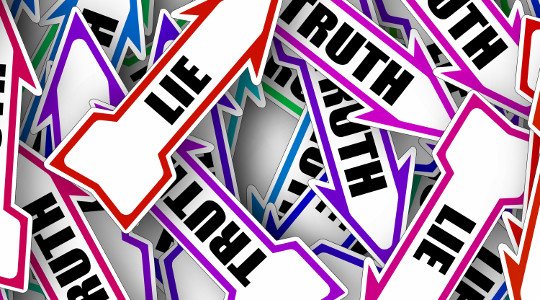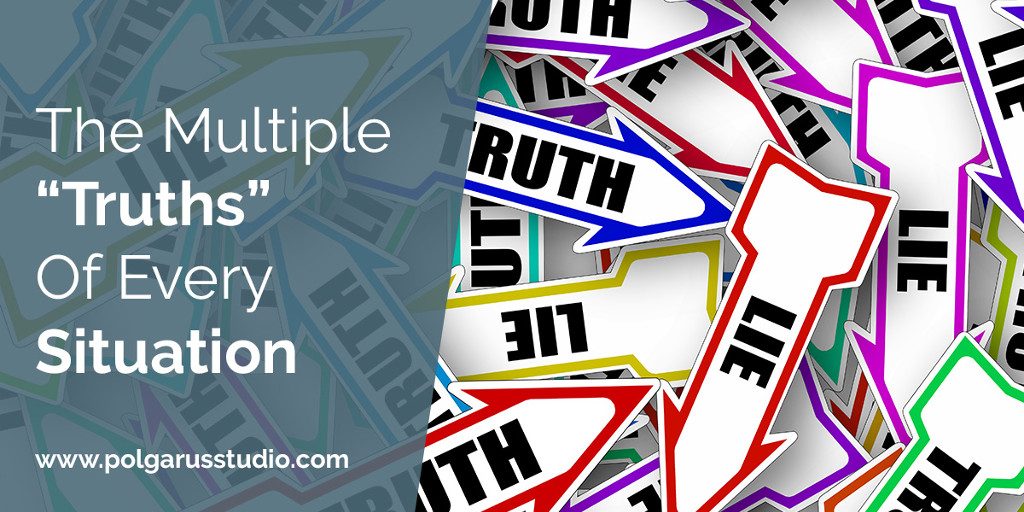“There are three sides to every story: your side, my side, and the truth. And no one is lying.” – Robert Evans
A trap that some books can fall into is presenting one set of information as the “truth” of the world, or what has happened. Everyone knows this truth, and everyone believes this truth.
But as we all know, the real world is never so clear-cut. Two people can see the same event, and come away with totally different “truths” about what happened. Two people can read a book or watch a movie, and have a different “truth” about the underlying message the creator was presenting. Two people can have a conversation and walk away with different “truths” about what was discussed.
Humans are very good at filling in missing bits of information. In nature, it can be a huge advantage when you’re looking for food or trying to avoid danger, but in a modern life, it can sometimes cause problems. This is because we rely on the prior “truths” we know to interpret what we’re experiencing currently.
I’ll start with a common example used in countless romance novels. The male lead of the story wants to organize a surprise for his partner (a party, a trip, maybe even a marriage proposal). He asks his sister/cousin/etc. (who his partner has never met) who is in the city for work to help him brainstorm ideas. They discuss things over dinner; then he walks with her back to the hotel she’s staying in to make sure she gets back safe.
While out on a “girls night,” the female lead sees her male partner having dinner with another woman. They seem very friendly, and when the dinner is over, they leave together and head to a hotel.
We all know the path the story is about to follow from here 🙂

But aside from the standard misunderstanding, you can also use the idea of “truth” when it comes to information being presented to a character in a story.
Take the example of a witness to a crime. The witness has had previous bad experiences with a particular group of people (e.g.: people from a certain race, religion, sexual orientation, etc.) They know that person X is part of that group. They can provide a list of all the suspicious things person X did in the lead-up to the event that makes them look guilty. And they tell the investigators that person X did it.
The only problem is, they never saw person X do the actual event – they saw just before, and just after, but because they have a preconceived “truth” about person X, they automatically fill in the missing bit. Later on, they might not even realize that they are filling in that missing bit – their “truth” is so ingrained, that they have created a memory of seeing something that never happened.
(And if the investigator also has a pre-conceived “truth” about the same group, they’re not going to try very hard to find other possible suspects when their truth is being confirmed. We’ve seen this in countless court cases over the years, with people wrongfully convicted of a crime because the investigators at the time were convinced they must have done it, and discounted any information they found that didn’t fit their “truth”.)
The “truth” that characters believe is also something you can use as a writer to color how the reader is presented with information. Take, for example, a story that has two main POV characters. They are both talking to a third person (I’ll call them Bob). The first POV character likes Bob, while the second POV character dislikes and distrusts Bob immensely.
When describing the conversation from the perspective of the first POV character, you can write about the happy and friendly manor Bob talks, how open and honest Bob is, and the exciting news that Bob gives them both at the end of the conversation.
Switching to the second POV character, you can give a different presentation. The fake welcome that Bob gives at the start of the conversation. The strange pauses that Bob makes as he talks, suggesting that he is lying or hiding something. And the obvious scam that Bob tries to get them involved in at the end of the conversation.
Whether you are overt with showing the differences in interpretation, or keep it as a subtle undertone that doesn’t start to become noticed until later in the book, it can be a handy way to add an unexpected twist.
Look at your story for the assumed “truths” that characters have, and then see if you can find a way to challenge that truth.

I love this article. So usefull